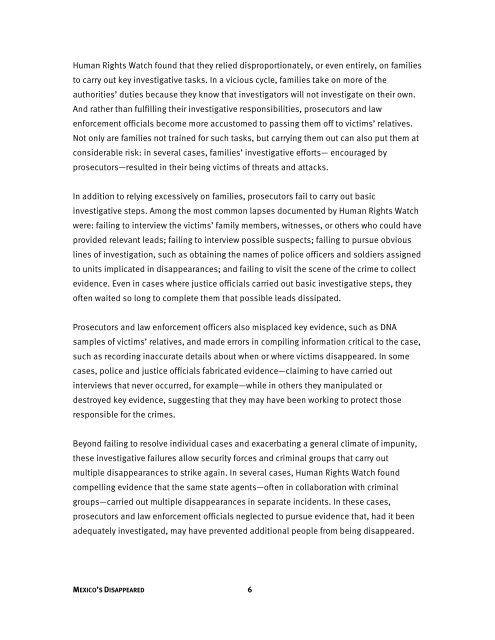Download the full report - Human Rights Watch
Download the full report - Human Rights Watch
Download the full report - Human Rights Watch
Create successful ePaper yourself
Turn your PDF publications into a flip-book with our unique Google optimized e-Paper software.
<strong>Human</strong> <strong>Rights</strong> <strong>Watch</strong> found that <strong>the</strong>y relied disproportionately, or even entirely, on families<br />
to carry out key investigative tasks. In a vicious cycle, families take on more of <strong>the</strong><br />
authorities’ duties because <strong>the</strong>y know that investigators will not investigate on <strong>the</strong>ir own.<br />
And ra<strong>the</strong>r than fulfilling <strong>the</strong>ir investigative responsibilities, prosecutors and law<br />
enforcement officials become more accustomed to passing <strong>the</strong>m off to victims’ relatives.<br />
Not only are families not trained for such tasks, but carrying <strong>the</strong>m out can also put <strong>the</strong>m at<br />
considerable risk: in several cases, families’ investigative efforts— encouraged by<br />
prosecutors—resulted in <strong>the</strong>ir being victims of threats and attacks.<br />
In addition to relying excessively on families, prosecutors fail to carry out basic<br />
investigative steps. Among <strong>the</strong> most common lapses documented by <strong>Human</strong> <strong>Rights</strong> <strong>Watch</strong><br />
were: failing to interview <strong>the</strong> victims’ family members, witnesses, or o<strong>the</strong>rs who could have<br />
provided relevant leads; failing to interview possible suspects; failing to pursue obvious<br />
lines of investigation, such as obtaining <strong>the</strong> names of police officers and soldiers assigned<br />
to units implicated in disappearances; and failing to visit <strong>the</strong> scene of <strong>the</strong> crime to collect<br />
evidence. Even in cases where justice officials carried out basic investigative steps, <strong>the</strong>y<br />
often waited so long to complete <strong>the</strong>m that possible leads dissipated.<br />
Prosecutors and law enforcement officers also misplaced key evidence, such as DNA<br />
samples of victims’ relatives, and made errors in compiling information critical to <strong>the</strong> case,<br />
such as recording inaccurate details about when or where victims disappeared. In some<br />
cases, police and justice officials fabricated evidence—claiming to have carried out<br />
interviews that never occurred, for example—while in o<strong>the</strong>rs <strong>the</strong>y manipulated or<br />
destroyed key evidence, suggesting that <strong>the</strong>y may have been working to protect those<br />
responsible for <strong>the</strong> crimes.<br />
Beyond failing to resolve individual cases and exacerbating a general climate of impunity,<br />
<strong>the</strong>se investigative failures allow security forces and criminal groups that carry out<br />
multiple disappearances to strike again. In several cases, <strong>Human</strong> <strong>Rights</strong> <strong>Watch</strong> found<br />
compelling evidence that <strong>the</strong> same state agents—often in collaboration with criminal<br />
groups—carried out multiple disappearances in separate incidents. In <strong>the</strong>se cases,<br />
prosecutors and law enforcement officials neglected to pursue evidence that, had it been<br />
adequately investigated, may have prevented additional people from being disappeared.<br />
MEXICO’S DISAPPEARED 6

















